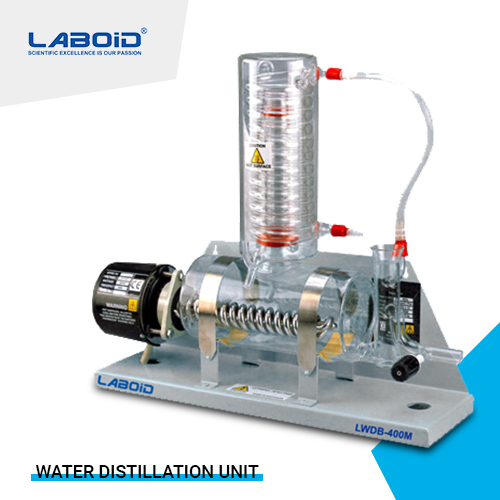Water distillation is a widely used method for purifying water, making it suitable for various applications. Whether it’s for drinking, laboratory use, or industrial processes, ensuring the proper operation of a water distillation unit is crucial for obtaining high-quality distilled water. In this article, we will explore the key steps and considerations to guarantee the efficient and effective functioning of a water distillation unit manufactured by Labroid International.
Ensuring Proper Operation of a Water Distillation Unit:
1. Regular Maintenance and Cleaning
To ensure the optimal performance of a water distillation unit, regular maintenance and cleaning are essential. There are some important actions to be taken here.
a. Cleaning the Condenser: The condenser is a critical component of the distillation unit, responsible for cooling the vapor and converting it back into liquid. Regularly check and clean the condenser to remove any mineral deposits or scaling that may accumulate over time, as these can hinder its efficiency.
b. Inspecting the Heating Element: The heating element plays a vital role in vaporizing the contaminated water. Inspect it periodically to ensure it is free from corrosion, scaling, or any other forms of damage that may affect its performance. Replace or repair any broken parts as necessary.
c. Descaling the Boiler: The boiler is subjected to high temperatures and is susceptible to mineral buildup. Descaling the boiler periodically will prevent scaling and enhance its heat transfer efficiency.
d. Replacing Filters: If your water distillation unit incorporates filters, they should be replaced as recommended by the manufacturer. Clogged or expired filters can affect the quality of the distilled water.
2. Monitoring Water Quality and Temperature
Monitoring the quality and temperature of the incoming water and the distilled water is crucial for ensuring the proper operation of a distillation unit. Here are some key steps to follow:
a. Water Quality Analysis: Regularly analyze the quality of the incoming water and the distilled water using appropriate testing methods. This will help identify any changes in water composition, such as the presence of impurities or contaminants. Adjust the distillation process parameters accordingly.
b. Temperature Control: Maintain proper control over the temperature of the distillation unit using precision Laboratory Instruments. The temperature should be set according to the specific requirements for the type of water to be distilled. Deviation from the optimum temperature range can affect the efficiency and quality of distilled water.
3. Operational Parameters and Safety Measures
Properly setting and monitoring the operational parameters of a water distillation unit is crucial for its efficient and safe functioning. Consider the following:
a. Distillation Rate: Determine the appropriate distillation rate based on the unit’s capacity and the required output. Distilling water at a rate exceeding the unit’s capacity can lead to inefficiency or even damage.
b. Vapor Control: Ensure proper control of the vapor flow within the distillation unit. Excessive vapor loss or inadequate condensation can lead to reduced efficiency and increased energy consumption.
c. Safety Measures: Install safety features such as pressure relief valves and temperature sensors to prevent any potential hazards. Regularly inspect these safety mechanisms to ensure they are in proper working condition.
4. Operator Training and Documentation
Properly trained operators and accurate documentation are vital for the effective operation of a water distillation unit. Consider the following:
a. Operator Training: Provide comprehensive training to the operators responsible for operating the distillation unit. They should be familiar with the unit’s components, operational procedures, safety measures, and troubleshooting techniques.
b. Standard Operating Procedures: Develop and maintain detailed standard operating procedures (SOPs) for operating the distillation unit. These SOPs should outline step-by-step instructions, safety protocols, and maintenance guidelines.
c. Recordkeeping: Maintain accurate records of maintenance activities, water quality analysis results, and any deviations or issues encountered during the operation. These records can help identify patterns, track performance, and facilitate troubleshooting if any problems arise.
Conclusion:
Ensuring the proper operation of a water distillation unit requires a systematic approach that includes regular maintenance, monitoring water quality and temperature, adhering to operational parameters, and providing operator training and documentation. By following these steps and considering the specific needs of your distillation unit, you can achieve optimal performance to increase the longevity of Labroid International equipment, and obtain high quality distilled water for your intended applications.
Frequently Asked Questions
Q.1 How do you test the purity of distilled water produced by a distillation unit?
Ans. Testing the purity of distilled water is typically done using a conductivity meter or a total dissolved solids (TDS) meter to measure the level of impurities present. Low conductivity or TDS reading indicates high purity.
Q.2 What regular maintenance tasks are necessary to ensure the proper functioning of a water distillation unit?
Ans. Routine maintenance tasks include cleaning the boiling chamber, descaling heating elements, checking for leaks, inspecting seals and gaskets, and replacing worn components such as filters and tubing.
Q.3 Are there specific indicators or alarms that signal potential issues with the operation of a water distillation unit?
Ans. Yes, water distillation units may have indicators or alarms for issues such as low water level, overheat, or bad components. These help alert operators to potential problems and prevent damage to the unit.
Q.4 How often should the components of a water distillation unit, such as heating elements and condenser coils, be inspected and replaced?
Ans. Components such as heating elements and condenser coils should be inspected at least annually or more frequently depending on usage and water quality. Replacement intervals vary but typically range from 1 to 5 years depending on manufacturer recommendations and conditions of use.
Q.5 What are the key parameters to monitor during the distillation process to ensure optimal performance and water quality?
Ans. The main parameters to monitor during distillation include temperature, pressure, flow rate and water quality measurements such as conductivity, pH and TDS levels. Maintaining optimum values for these parameters ensures efficient distillation and high quality water production.

